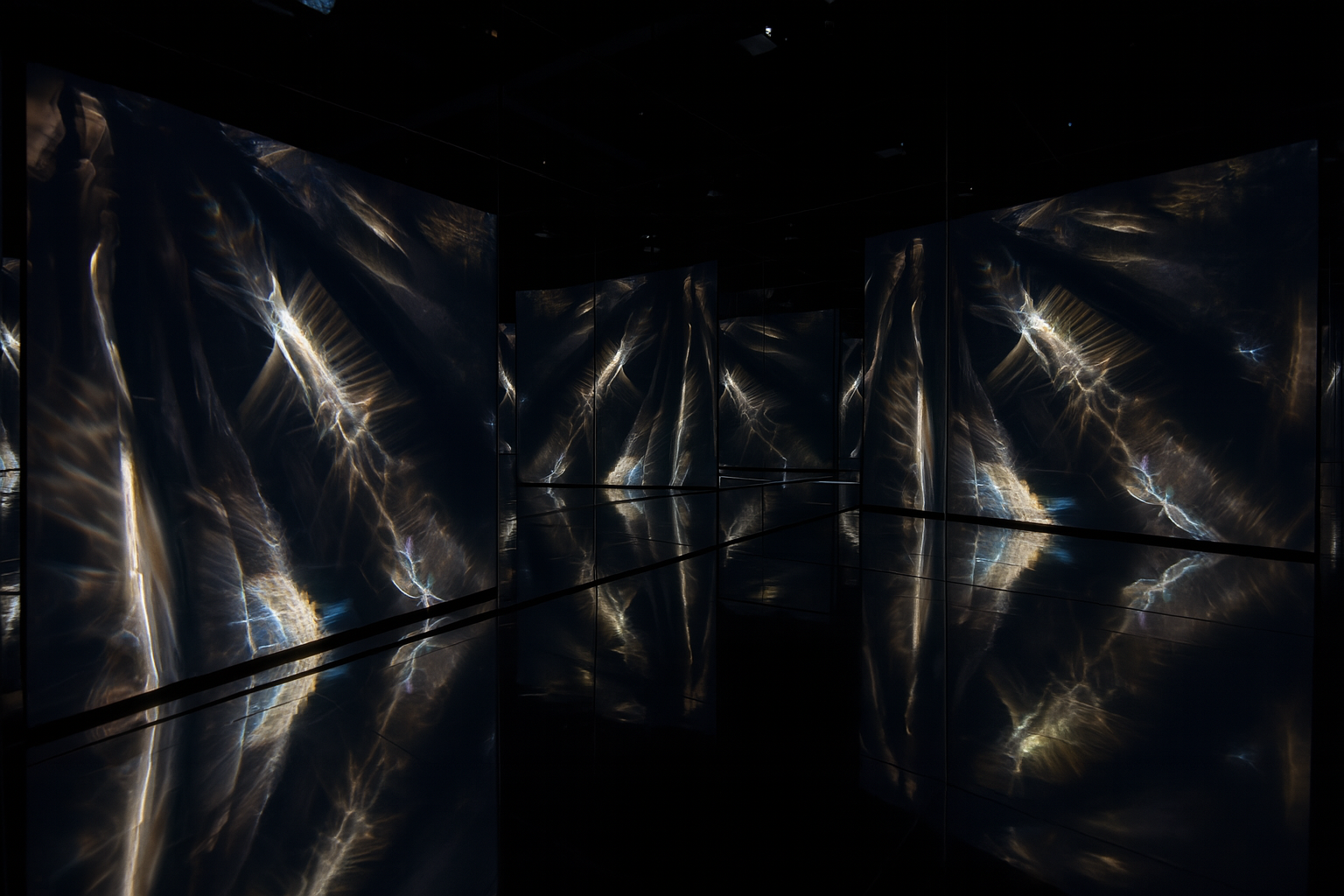FANTOMATYKA
immersive film | expanded cinema
Duration: 9 minutes
Release: 2026
Genre: Experimental/Abstract
Format: Adaptive (flat/giant screen, fulldome, circular 360°, frameless, VR 180°3D)
Master resolution: 8K
Produced by: Julia Set Lab
Synopsis
Something moves, even before it has a name.
Fantomatyka investigates the birth of time and consciousness through visual abstraction — a journey that begins from stillness and the formless, unfolds through rhythm and transformation, and culminates in the awakening of perception.
A subtle energy gathers, contracts, opens: it is not yet form, not yet thought. It is the motionless time in which everything could begin, but has not yet begun. A vibration flows beneath the surface, like an unrealized intuition — a perception balanced between presence and disappearance. A hint appears and immediately withdraws, leaving an ambiguous trace, like an echo without origin.
In this threshold, the meaning of Fantomatyka reveals itself: a presence that never fully defines itself, appearing and vanishing in a single gesture, inhabiting the interval between what is real and what is only perceived.
The film unfolds in three movements, like a musical form that does not progress toward resolution but evokes: Emergence, Threshold, Revenant. A continuous flow of images, rhythms, and resonances builds a sensory experience where every meaning remains perceptually suspended, and every form dissolves at the very moment it tries to emerge.
Fantomatyka is a visual exploration of what cannot be said — a language of images that expresses the inexpressible. It is a work designed to touch without grasping, existing between what we are certain we have seen and what we may have only imagined.
Act I — Emergence
From formless matter, the first structures of the world emerge.
Light crosses the substance, generating movements, rhythms, and temporary geometries.
It is the birth of perception: a universe observing itself for the first time.
Every form seems to recall a common origin — as if chaos itself were learning to breathe.
The eye no longer distinguishes between the microscopic and the cosmic, between the cell and the galaxy: everything vibrates within the same impulse of existence.
Act II — Threshold
Experience becomes aware of itself: energy organizes, reflects, and duplicates.
The threshold is crossed.
Matter becomes mind, movement becomes memory.
Visions of expansion and collapse alternate in a continuous state of metamorphosis, where perception loses and finds itself again.
It is the moment when the universe begins to question its own identity — a dream observing itself dream.
Act III — Revenant
The energy of the film ascends toward the light.
After chaos and transformation, every form dissolves, leaving only the most fragile sound — the breath of a newborn.
From that breath, consciousness re-emerges, as if the universe itself were learning to exist once more.
Fantomatyka ends where everything begins again: in the subtle pulse between the heart and the infinite.
Fantomatica part.1 Emergence
Fantomatica part.2 Threshold
What is Fantomatyka?
The term Fantomatyka was coined by Stanisław Lem in his essay Summa Technologiae (1964), to describe a technology capable of generating fully artificial sensory experiences, indistinguishable from reality.
Fantomatyka (Fantomatica) is a transmedia film project conceived to adapt seamlessly to emerging projection technologies — from immersive cinema and fulldome to video mapping, holographic projections and LED walls.
Visual abstraction is its primary language: a flow of experimental imagery created through live-action sequences and high-resolution (up to 12K), exploratory footage. The soundscape follows the same approach, composed through live sessions with modular synthesizers and spatialized sound design.
All visuals are handcrafted and entirely non-CGI.
The film was created using a combination of real fluids, optical phenomena, and specially modified lenses.
Each shot emerges from a physical interaction between light, matter, and movement — captured directly in camera through an artisanal, experimental process.
The spectator is guided through a liminal dream, a non-human point of view, disembodied and wandering in a space of metamorphosis — beyond time and logic.
The aesthetic oscillates between the microscopic and the cosmic, the figurative and the abstract, the organic and the artificial.
Transmedial project
With high-resolution footage and a solid background in immersive cinema, Fantomatyka was conceived as a transmedia project designed to seamlessly adapt to a wide range of formats, including immersive cinema and theatre, fulldome projection, video mapping, and large-scale LED installations.
Credits:
Sandro Bocci | producer, film maker
Mishikatomo | composer, sound designer
Sara Tassotti | art director, concept design
Produced by Julia Set Lab
Previous Project
Fantomatica follows the path opened by Cosmonautica, our previous immersive film project that premiered at the CERN in Geneva and was showcased at the Syllepse dome.
Entirely created without CGI, Cosmonautica received international acclaim and was awarded First Prize at Light Year Digital Art 2024 (China) as Best Immersive Work. This recognition affirmed our commitment to pushing the boundaries of sensory cinema through real, in-camera experimentation.






